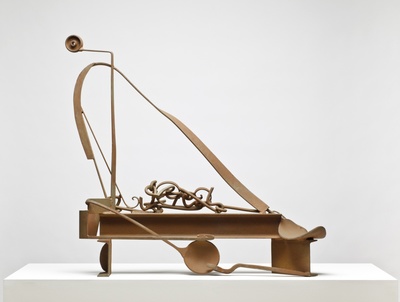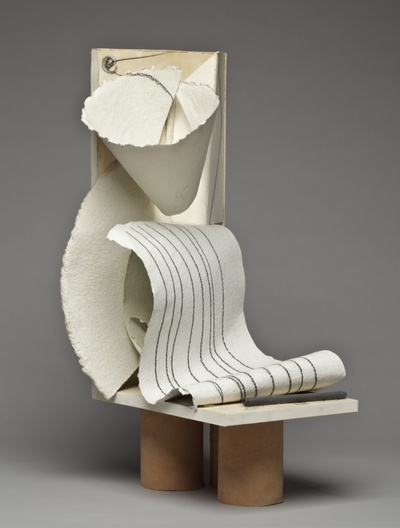Beast in the Living Room
By Stephen Vincent Kobasa
Is there any sculptor so resistant to domestication as Sir Anthony Caro? The reality of this fact is, perhaps unintentionally, made clear in a concise retrospective currently at the Yale Center for British Art.

Anthony Caro, Catalan Scrawl, 1987–88, steel, rusted and fixed, 41 x 40 x 13″. Private collection, London.
The Yale installation reads like a roadside menagerie with an assemblage of too small cages in which animals pace frantically back and forth on the way to madness. More benignly, it appears like a latter day natural history cabinet with its species-specific groupings of objects presented as coffee table artifacts. The radical edge balancing of these works, resentful of their pedestals, suggests an advertisement for executives’ office toys. They are gizmos deployed with a preference for their illusory charm, not their brazen dismantling of space. Caro’s Table Piece Z-69, reminiscent of nothing so much as Alberto Giacometti’s 1932 cast bronze Woman with Her Throat Cut, is elevated on a platform so high that all sense of looking down at a crime scene is erased from it.
Some sculptures escape being muted by the upholstered comfort of the Yale setting. Several of Caro’s early works in bronze show the influence of Henry Moore, whose studio assistant he was for a time, but with a wonderfully bulgy sense of humor that Moore never evokes. Among a group of bronze miniatures that could be toy theaters for Spartan children, the very recent Sackbut (2011–2012) stands out as a compact brutality of folded metal.

Anthony Caro, Paper Sculpture No. 98, 1981, pencil, chalk, acrylic, handmade paper, and Tycore on cardboard tubes filled with leadshot. Private collection, London.
The works of paper register as small-scale magic, fashioned for the artist’s own curiosity and pleasure, rather than for the clever decorations this exhibition makes of them. They do not quite manage the inventiveness of Matisse’s late cut-outs, except perhaps for Paper Sculpture No. 98, possessed as it is of what might be the lines of an autobiographical electrocardiogram. In the same way, the clay-metal assemblages give an almost flippant, “how easy it is, then” impression, though a piece solely of stoneware entitled Minoan lives up to its name in evoking an excavated past.
Yet the power Caro maintains over steel is clear enough in the recognizable fragments of metal ladle and clamps in Catalan Scrawl, a collage of infernal qualities conjuring a machine from Kafka’s penal colony, and the broken slab like a grave marker extending deep below ground of Table Piece CLXVIII.

Anthony Caro, Ocean, 1982–1983, rusted steel. Yale University Art Gallery. Charles B. Benenson, B.A. 1933, Collection. Photograph by Stephen Kobasa.
The most assertive presence of the sculptor is apparent in a view, through a gallery museum window, of Caro’s monumental Ocean, where, in a planned coincidence, the Yale University Art Gallery has sited it. There it sits, stentorian on the street; an unconfined imperial monster.
Caro: Close-Up is curated by Julius Bryant, Keeper of Word & Image, Victoria and Albert Museum; the organizing curator at the Center is Martina Droth, Head of Research and Curator of Sculpture. A fully illustrated book published by the Center in association with Yale University Press accompanies the exhibition.
Through December 30, 2012
Yale Center for British Art
New Haven, CT
britishart.yale.edu
